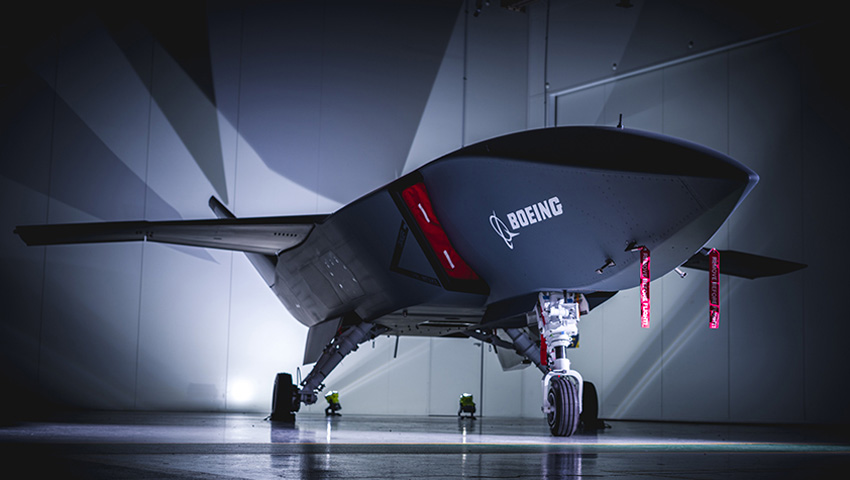The Loyal Wingman program could be the catalyst for a “fundamental shift” in Australia’s conception of air power, according to one analyst.
To continue reading the rest of this article, please log in.
Create free account to get unlimited news articles and more!
Back in February 2019, the Commonwealth government unveiled plans to develop a new unmanned aircraft in collaboration with Boeing Australia — the Boeing Airpower Teaming System, otherwise known as the ‘Loyal Wingman’.
The aircraft — measuring 11.7 metres long and with a range of 2,000 nautical miles — is expected to deliver fighter-like performance, while also offering intelligence, surveillance and reconnaissance (ISR) capabilities
The drones are designed to leverage artificial intelligence to fly independently or in support of manned aircraft while maintaining safe distance between other jets.
The government initially ordered three aircraft, but has since doubled the size of the fleet following the Loyal Wingman’s first successful flight late last month.
According to Dr Malcolm Davis, senior analyst at the Australian Strategic Policy Institute (ASPI), the successful flight “opens up a new path” for the Royal Australian Air Force.
Dr Davis writes that the drone’s “rapid development” over a three-year period “illuminates the RAAF’s path into the future”.
The analyst references remarks made by head of air force capability, Air Vice Marshal Catherine Roberts, who said that future airpower must be developed at a “speed of relevance to technological change”.
“The paradigm of aircraft being fielded after a 20-year acquisition cycle and billions of dollars of investment is yesterday’s capability development model,” Dr Davis argues.
“It’s increasingly at odds with the pace of technological change and with the rapidly developing combat capabilities of potential adversaries.
“If the RAAF is to reduce the risk of technological and operational surprise, its thinking about the future can no longer be based on multi-decade timelines for new capabilities.”
Dr Davis questions timelines outlined in the 2020 Force Structure Plan, which suggest that studies of options to replace the F-35A would begin in the late 2030s.
“It would make much more sense to embrace the approach adopted for the Loyal Wingman project, by beginning analysis of alternatives for the F-35A replacement now, in a manner that could then align with US work on the Next-Generation Air Dominance (NGAD) system,” he continues.
“That will be a mix of crewed and autonomous platforms, with an emphasis on rapid development through a ‘digital century series’ model.
“Loyal Wingman essentially embraces this model. Boeing is clearly poised to use it to compete for the US Air Force’s ‘Skyborg’ program, and it may well be exported to other markets.”
According to Dr Davis, co-operative development by Washington and Canberra could see NGAD introduced earlier than the typical 20-year acquisition cycle.
“The first flight of Loyal Wingman highlights a real opportunity for Australia’s defence industry. There’s debate emerging in the US over the future of the F-35, and high operating and sustainment costs could see its numbers reduced to 1,050 jets from a planned purchase of 1,763,” Dr Davis writes.
“There’s talk of undertaking a clean-sheet design for a fourth-generation-plus or fifth-generation-minus aircraft to replace the F-16 and ease reliance on the F-35 as a complete airpower solution.
“Certainly, the USAF could embark on production of a new crewed aircraft, but there’s a risk that history could repeat itself with escalating operational requirements driving up cost and complexity.”
He adds: “Australia’s loyal wingman offers a better alternative, and Boeing Australia and Defence must be ready to promote such a capability that can meet both American and Australian needs.”
Davis echoes remarks made by ASPI colleague, Marcus Hellyer, who has previously claimed that the Loyal Wingman could evolve into a suite of multi-purpose vehicles, capable of carrying different payloads, including strike munitions, and intelligence, surveillance and reconnaissance (ISR) capabilities.
“It may become a range of larger or smaller platforms with varied ranges and payloads. A larger ‘son of Loyal Wingman’ could, for example, have different engines that enable higher speed and greater performance,” Dr Davis writes.
“In addition to developing a cheaper alternative to crewed bombers such as the B-21 Raider, such a platform could also undertake long-range air-dominance missions.”
The analyst claims that an evolved Loyal Wingman “could ultimately undertake both electronic warfare and attack roles”, carrying both directed-energy and hypersonic weapons.
“That could drastically transform how the RAAF undertakes strike and air-combat operations. Greater range is a must, given that Australia’s location means battles would occur over vast distances,” he adds.
Dr Davis says the Loyal Wingman program could prompt the RAAF to rethink its force structure, from a dependence on “small, boutique forces” to an embrace of “mass”.
“In a major conflict, aircraft are very likely to be lost and our ability to undertake operations could be short-lived,” he writes.
“It’s better to build mass through uncrewed, autonomous systems like loyal wingman, rather than continue to rely on small, boutique forces or try to build larger forces with crewed platforms.
“Relying purely on a technological or qualitative edge for small forces is rapidly becoming a losing strategy in the face of China’s growing airpower capability — and quantity has a quality all of its own.”
Dr Davis concludes that the Loyal Wingman program may signal the start of a “fundamental shift” in Australia’s conception of air power.
“Its significance may well compare with the rapid modernisation and transformation of airpower during and after World War I,” he writes.
“In 2021, the beginning of the rise of autonomous systems and manned–unmanned teaming, and, most importantly, digital design and engineering for rapid acquisition are new and herald a future transformation of similar significance to that of 100 years ago.”
Get involved with the discussion and let us know your thoughts on Australia's future role and position in the Indo-Pacific region and what you would like to see from Australia's political leaders in terms of partisan and bipartisan agenda setting in the comments section below, or get in touch with
Charbel Kadib
News Editor – Defence and Security, Momentum Media
Prior to joining the defence and aerospace team in 2020, Charbel was news editor of The Adviser and Mortgage Business, where he covered developments in the banking and financial services sector for three years. Charbel has a keen interest in geopolitics and international relations, graduating from the University of Notre Dame with a double major in politics and journalism. Charbel has also completed internships with The Australian Department of Communications and the Arts and public relations agency Fifty Acres.

 Login
Login








